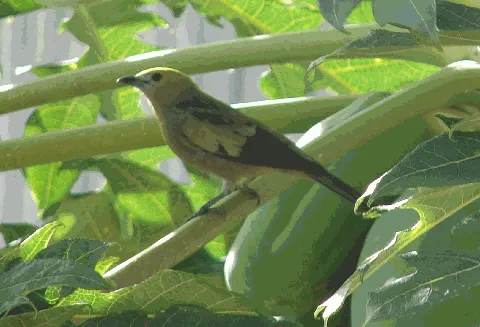
Palm Tanager
[order] Passeriformes | [family] Thraupidae | [latin] Thraupis palmarum | [UK] Palm Tanager | [FR] Tangara des palmiers | [DE] almentangare | [ES] Azulejo Palmero | [IT] Tangara delle palme | [NL] Palmtangare
Subspecies
| Genus | Species | subspecies | Breeding Range | Breeding Range 2 | Non Breeding Range |
| Thraupis | palmarum | LA | Guatemala to Paraguay and s Brazil | ||
| Thraupis | palmarum | atripennis | |||
| Thraupis | palmarum | melanoptera | |||
| Thraupis | palmarum | palmarum | |||
| Thraupis | palmarum | violilavata |
Physical charateristics
It is olive-grey in colour with a pale-grey tinge to the head and the wing-coverts. The end of the wings looks black when closed.
Listen to the sound of Palm Tanager
[audio:http://www.aviflevoland.nl/sounddb/P/Palm Tanager.mp3]
Copyright remark: Most sounds derived from xeno-canto
| wingspan min.: | 0 | cm | wingspan max.: | 0 | cm |
| size min.: | 18 | cm | size max.: | 19 | cm |
| incubation min.: | 14 | days | incubation max.: | 15 | days |
| fledging min.: | 17 | days | fledging max.: | 18 | days |
| broods: | 1 | eggs min.: | 1 | ||
| eggs max.: | 3 |
Range
This tanager is a resident breeder from Nicaragua south to Bolivia, Paraguay and southern Brazil. It also breeds on Trinidad and, since 1962, on Tobago. In Trinidad and Tobago. The Palm Tanager is widespread from Honduras to Panama and southwards east of the Andes to central Bolivia and south-east Brazil and west of the Andes to south-west Ecuador.
Habitat
As its name suggests, it seems to like habitat with palms on which it feeds but it is also common in gardens, farmland and in forest and woodland borders.
Reproduction
The bulky cup nest is built in a tree, usually a palm, or under the eaves of a house, and the female incubates three, sometimes two, brown-blotched cream eggs for 14 days, with another 17 days to fledging.
Feeding habits
It normally feeds singly or in pairs, and like the Blue-gray Tanager prefers to feed well
above the ground (over 5 meter). The Palm Tanager’sm ethod of insect-searchinigs quite specialized. It forages almost exclusively among leaves, usually very large leaves,
and to do this it clings vertically head downward, or upside down. to the petiole of the leaf or the leaf itself. When examining the leaf of a coconut palm, the Palm Tanager starts on the upper surface of a leaflet and then works towards the tip, its weight causing the leaflet to hang down with the bird hanging vertically to it. Palm leaves are particularly hard and slippery and must be difficult to cling to, and the Palm Tanager was the only species ever seen foraging on them. An examination of live birds and freshly dead specimens showed that the Palm Tanager’s claws are noticeably sharper than those of the other tanagers. Its tail averages 7 mm longer than the Blue-gray Tanager’s, a rather greater difference than would be expected from its slightly greater size. Possibly this is advantageous for clinging head downward and upside down. It lacks the specialized fruit-eating behavior of the Blue-gray Tanager. It can take rather larger fruits than the latter, swallowing fruits whole instead of pecking pieces out of them.
above the ground (over 5 meter). The Palm Tanager’sm ethod of insect-searchinigs quite specialized. It forages almost exclusively among leaves, usually very large leaves,
and to do this it clings vertically head downward, or upside down. to the petiole of the leaf or the leaf itself. When examining the leaf of a coconut palm, the Palm Tanager starts on the upper surface of a leaflet and then works towards the tip, its weight causing the leaflet to hang down with the bird hanging vertically to it. Palm leaves are particularly hard and slippery and must be difficult to cling to, and the Palm Tanager was the only species ever seen foraging on them. An examination of live birds and freshly dead specimens showed that the Palm Tanager’s claws are noticeably sharper than those of the other tanagers. Its tail averages 7 mm longer than the Blue-gray Tanager’s, a rather greater difference than would be expected from its slightly greater size. Possibly this is advantageous for clinging head downward and upside down. It lacks the specialized fruit-eating behavior of the Blue-gray Tanager. It can take rather larger fruits than the latter, swallowing fruits whole instead of pecking pieces out of them.
Conservation
This species has a large range, with an estimated global extent of occurrence of 12,000,000 km². The global population size has not been quantified, but it is believed to be large as the species is described as ‘common’ in at least parts of its range (Stotz et al. 1996). Global population trends have not been quantified, but the species is not believed to approach the thresholds for the population decline criterion of the IUCN Red List (i.e., declining more than 30% in ten years or three generations). For these reasons, the species is evaluated as Least Concern.

Migration
Sedentary throughout range
Distribution map

Literature
Title Ecological relationships between feather mites (Acari) and wild birds of
Emberizidae (Aves) in a fragment of Atlantic Forest in northeastern Brazil
Emberizidae (Aves) in a fragment of Atlantic Forest in northeastern Brazil
Author(s): Rachel M. de Lyra-Neves Angela M. Isidro de Farias & Wallace R. Telino-Junior
Abstract: The objective of this study was to investigate fea..[more]..
Source: Revista Brasileira de Zoologia 20 (3): 481-485, 2003
Title SUGAR-TASTING ABILITY AND FRUIT SELECTION IN TROPICAL FRUIT-EATING BIRDS
Author(s): DOUGLAS J. LEVEY
Abstract: The sugar-tasting abilities of four species of tan..[more]..
Source: The Auk 104: 173-179
]]>
